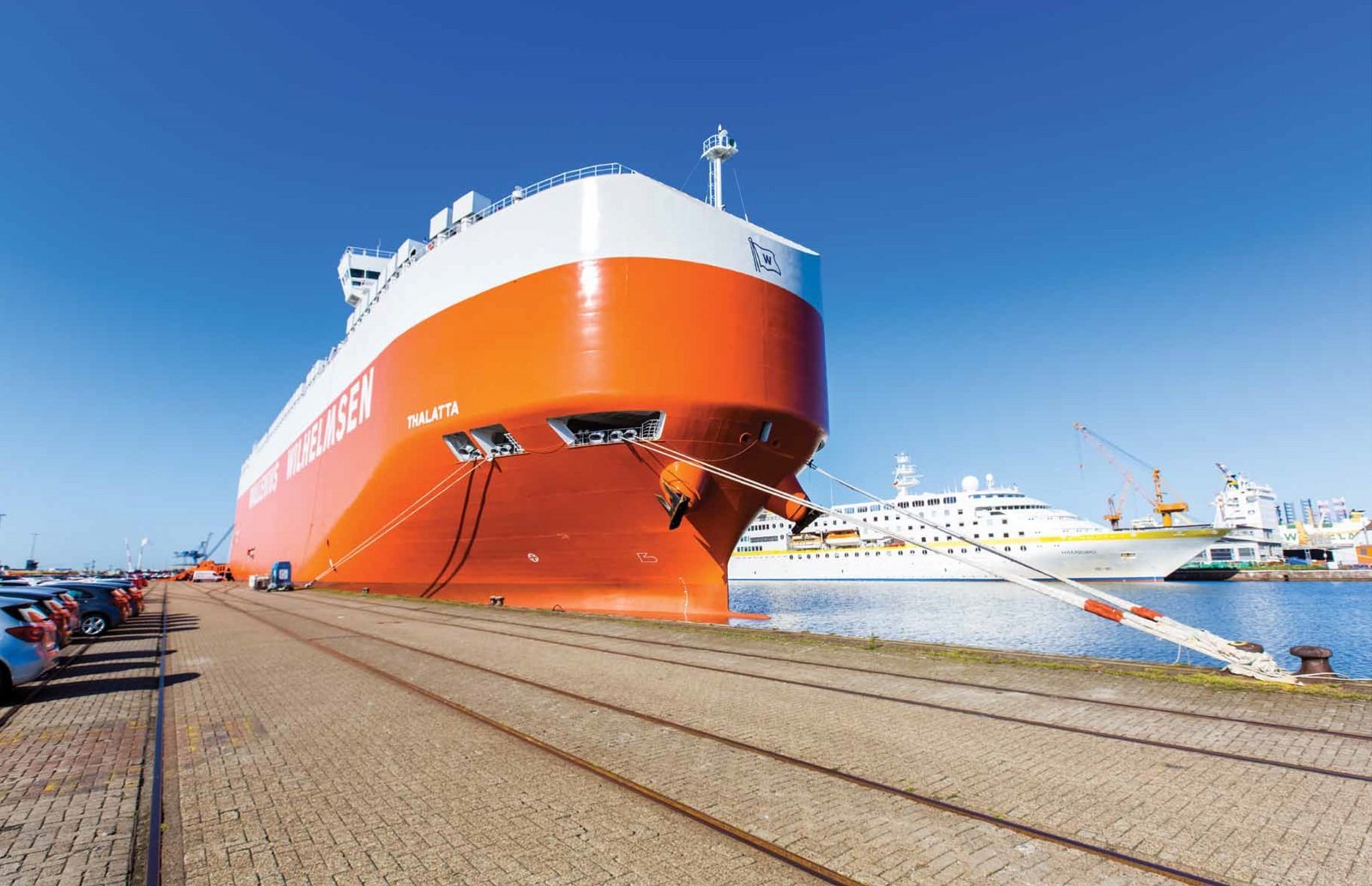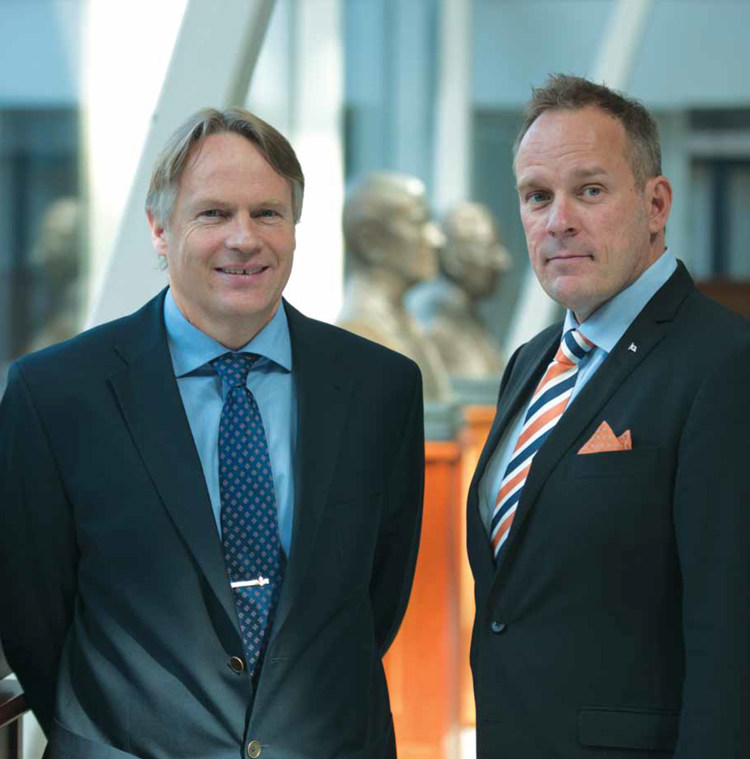
Building super HEROes: High efficiency ro-ro vessels
A new generation of ro-ro vessels are emerging at Wilh. Wilhelmsen, offering enhanced flexibility, capacity, efficiency and crew facilities. Their mission? Long-term commercial success in a continually changing market. Lars Dessen and Filip Svensson unmask their HEROes.
-
Text:Kongsberg Maritime Communication
-
Gunvor Hatling MidtbøVice President, Communications
If Lars Dessen and Filip Svensson could have a superpower, it’d most probably be the ability to see into the future.
Sat at a polished boardroom table in Wilh. Wilhelmsen’s (WW) Oslo-based headquarters, Dessen, Head of WW Vessel Design, and Svensson, the firm’s Vice President Marine Operations Shipping, are discussing the challenges of creating newbuilds that deliver optimal performance over their entire lifecycle, namely some 30 years.
“It’s a challenge,” admits Dessen, with an air of understatement, “but one we feel we’re well-positioned to meet, through our operational experience, commercial success in the segment, and technical expertise. That unique understanding has directly fed into our latest vessel series, the HEROes.
LET'S ROLL
The HERO name stands for ‘high efficiency ro-ro’ and relates to a series of four Post-Panamax ships from Hyundai Samho Heavy Industries in Mokpo, South Korea. Two of these, the Thermopylae and the Thalatta, have been delivered this year, with their companions scheduled to arrive in January and June 2016. Each vessel is 36.5m wide, 199.99m long and, thanks to a total of 13 decks, five of which are liftable, can transport up to 8,000 car equivalent units.
“The extra width allowed in the new Panama Canal gave us the potential to add the 13th deck,” explains Svensson, “which translates to an extra 700 car units. However, by staying under 37m width and 200m length we can service all of the operator’s (Wallenius Wilhelmsen Logistics) key ports, while the draft means they can also call at ports with shallower depths, increasing the geographical scope of service. This makes the HEROes very versatile vessels.”
That versatility is further enhanced by the liftable decks, which, Dessen explains, allow them to adapt to the changing needs of the industry. “The moveable decks give us the ability to configure the vessel to meet individual customer requirements,” he states, “accommodating cargo of varying sizes and increasing capacity for cars, trucks, equipment, and break-bulk. The decks can be lowered for all-car loads, or raised to fit the requirements of high and heavy cargo.
“Times change and cargo composition changes,” Dessen continues, “and this gives us the ability to be as flexible as the industry needs us to be, ensuring the success of our assets for the long-term.”

HERO BY NAME, HERO BY NATURE
The HEROes give the industry more, and the environment less while having less impact on the environment. By feeding existing operational data from current vessels into the design process, Dessen and his team provided the yard with a detailed operational profile, allowing them to optimise the hull in line with the vessels’ exact needs. In effect this has resulted in a slightly reduced top speed, but greatly enhanced overall efficiency.
When combined with an Exhaust Gas Cleaning System (a first for WW newbuilds), a new propeller and Promas rudder solution, and engines configured for optimal efficiency at a wider range of speeds and drafts, the result is, as Dessen surmises, “an environmentally sound vessel with reduced fuel consumption and less emissions per transported unit.”
A win-win then – for both the environment and the industry. And it doesn’t stop there.
Like any real HERO, each one is focused on caring for, and protecting, its people. This, Svensson says, is key to understanding the ships and the very philosophy of Wilh. Wilhelmsen itself.
THE PERSONNEL TOUCH
“An important part of long-term success is looking after your peo- ple,” he comments, going on to state that the business has around 11, 500 crewmembers and a staggering retention rate of 99.8%.
“No one ever leaves,” he laughs, before supressing the smile to add, “and that’s the key to retaining and continually developing ex- pertise.
“Our people are Wilh. Wilhelmsen’s most important asset, so we want to provide them with optimal living and working conditions. The HEROes are proof of that commitment.”
Svensson goes on to describe how the vessels have been designed to separate work and rest areas, reducing noise and directing the flow of movement – of both cargo and outside visitors – away from living quarters. In addition, a protected walkway on the upper deck safeguards crew at sea, while the elevator is positioned on the star- board side to ensure people don’t have to cross the cargo deck to enter and leave the vessels.
And, if they have to rescue a man overboard or someone in dis- tress, this difficult task is made as easy as possible.
“As in recent designs, the rescue boat on the HEROes is positioned in a recess in the hull, instead of on the upper deck,” Dessen notes. “This reduces the drop and makes it much easier for the crew to de- ploy, especially in bad weather. It comes at the cost of a little cargo space, but is a better solution for crew safety. That makes it an easy choice.”

The latest addition to the WW fleet – the 8,000 car unit capacity Thalatta.
PARTNERS FOR LIFE
Relationships are clearly important to Wilh. Wilhelmsen. Solid relationships provide a foundation for long-term success – with customers, employees and also, it seems, with suppliers.
The firm has been working with Kongsberg Maritime since 1969, when Norcontrol installed the world’s first ever computerised engine monitoring and navigation system on the M/S Taimyr. Today the K-Chief 600 marine automation system provides the HEROes with cost efficient control, management and monitoring solutions, while an on-going fleetwide service agreement ensures that wherever and whenever the ship- owner needs assistance, Kongsberg Maritime will be there.
“This is another key to optimal, predictable performance throughout a vessel lifecycle – having partners you can trust,” comments Svensson. “There are numerous important elements to that.
“Firstly it’s crucial to have a supplier that has a global network of facilities and service engineers. We have a global fleet, with global operations, and it’s important they can accommodate that, 24/7. Then you have to have a dialogue. By that I mean a supplier that listens to your needs and is always working to supply reliable, user-friendly systems that satisfy them, rather than simply trying to sell what they have. Without that dialogue you have no understanding and no positive development.”
Dessen adds, and Svensson quickly agrees, that long-term stability is also a precondition to putting pen to paper: “We use makers that have been around for a long time,” he notes.
“These vessels have lengthy lifecycles and we have to know that, in 10 or 20 years time, we’ll be able to source the spares and support we need. The alternative is replacing entire systems, which is, obvi- ously, highly inefficient.”
Something that definitely does not conform to their philosophy. Dessen and Svensson may be lacking the superpower to make their lives much easier, but, thanks to a strategy that puts efficiency, flexibility and people first they seem perfectly placed to tackle the challenges arising over their new vessels’ lifecycles.
The industry, they believe, needs new HEROes. And Wilh. Wilhelmsen is dedicated to supplying them.